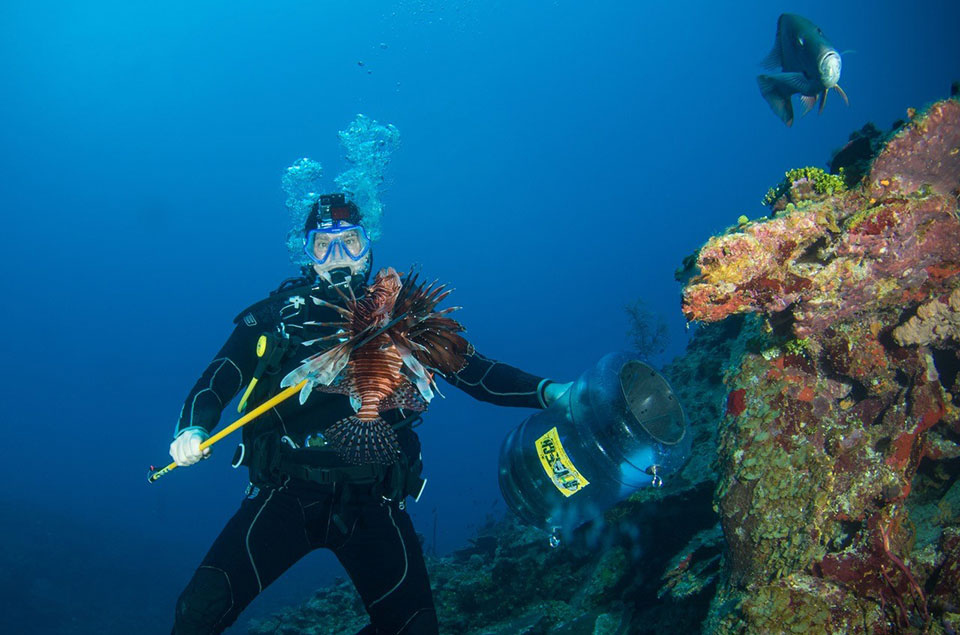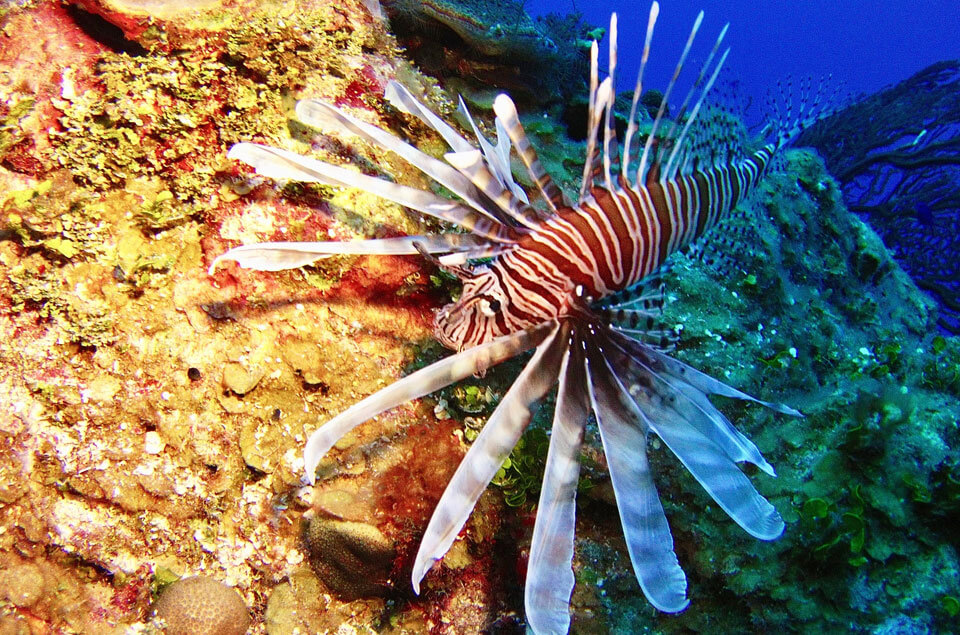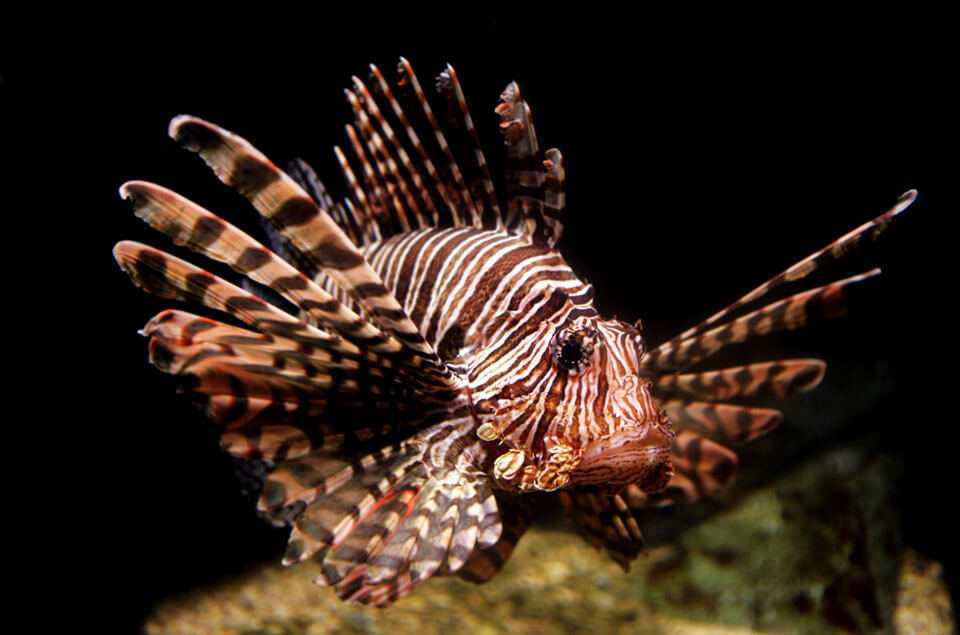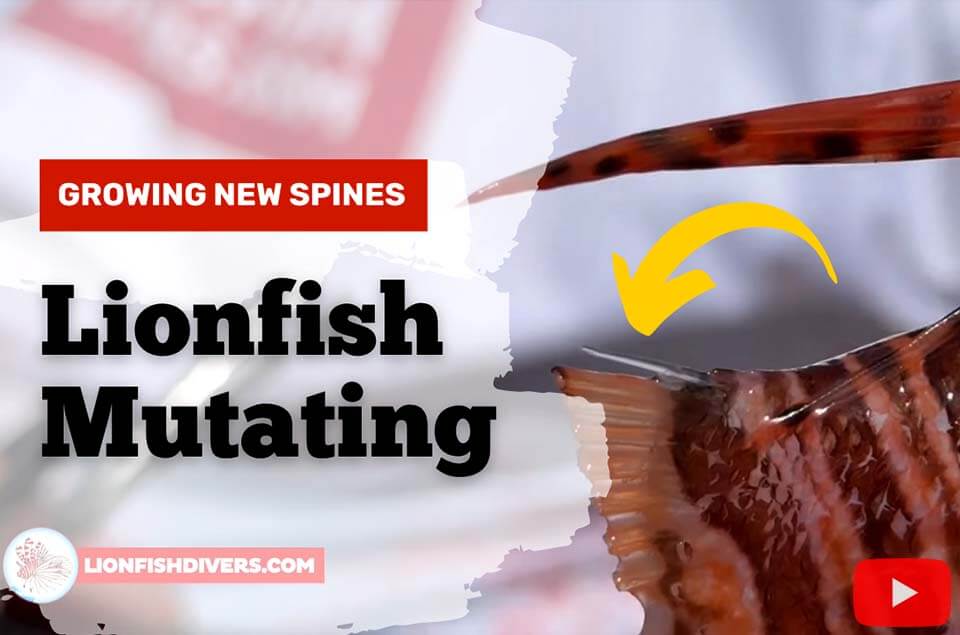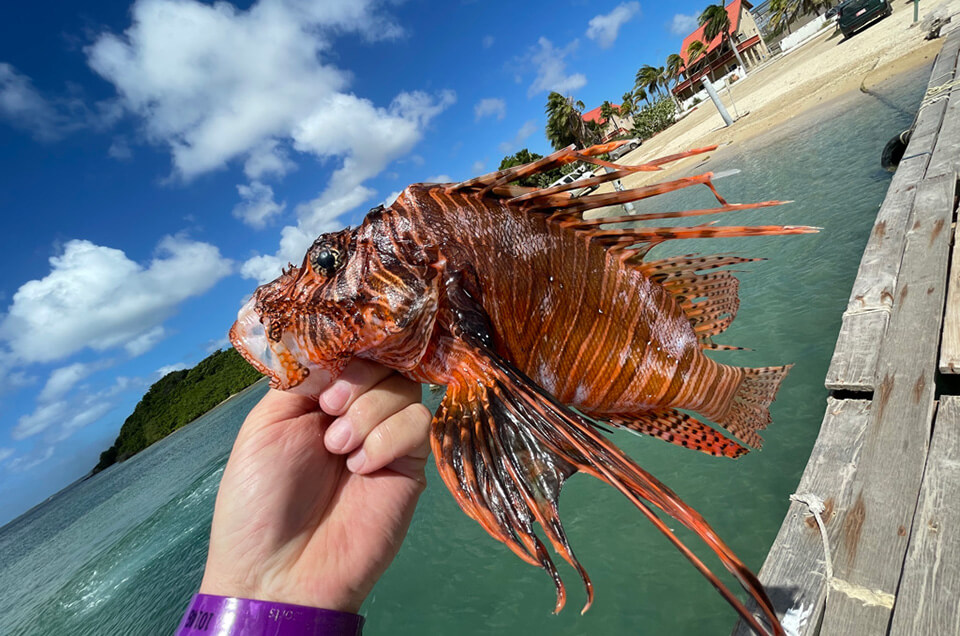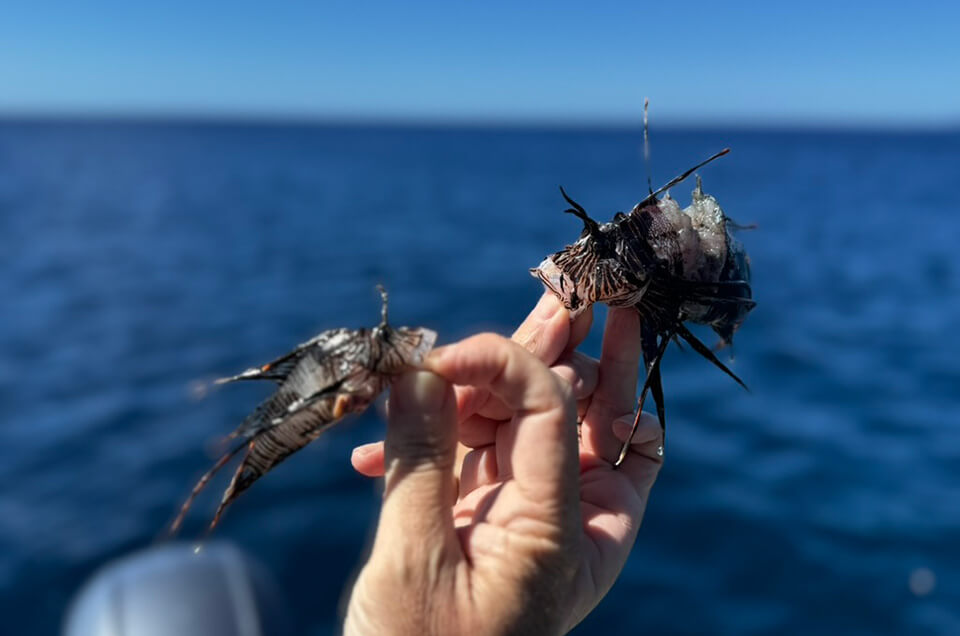Lionfish Are Damaging Our Underwater Environment
Contributors Roger J. Muller, Jr. & Kelsey M. Muller,
PADI Dive-master & Instructors
One Scuba Diver’s Mission
With their long feather like fins and spotted or banded spines, it is likely Lionfish have been marveled at for as long as man has explored the seas. These exotic fish, while intriguing to look at, can be dangerous to encounter with their venomous spines, which can lead to severe pain, blistering and even paralysis. I would know – I’ve been stung before! When removed from their natural habitat in the Indo Pacific and placed in North America, the fish can also have devastating effects on local ecosystems due to their lack of natural predators.
I’ve traveled across North and Central America in order to pursue and eliminate these venomous creatures. Partnering with local organizations, I’ve surveyed and tracked Lionfish in Cuba, Panama, St. Croix, Bonaire, Aruba, Curaçao, Bahamas, United States, Grand Caymans, and Jamaica, where these populations have reached a critical level. It is my mission to eradicate this invasive species and help to restore the natural order in the North American marine ecosystem.
Here are some of my favorite stories, tips, tricks and fun facts from my adventures as an international Lionfish hunter. In this article you’ll find a first hand account of:
- What are Lionfish and where do they come from?
- Why their presence in North America is alarming
- How to handle and care for a Lionfish sting
- How to clean, cook and prepare a delicious Lionfish meal
- Where to find local organizations and courses that are educating the public on this initiative
An Introduction to Lionfish
Let’s back up a second – if I’m going to tell you more about my quest to eradicate this invasive species we should start with a simple question – what are Lionfish anyways?
The Common Lionfish, or Pterois volitans, is a venomous, tropical fish that in my opinion looks a bit like a dark orange and white underwater zebra. It is native to the region between the South Pacific and Indian Oceans – think west of Africa, south of the Middle East and India, and north of Australia all the way up to China. This fish gets its name from the Greek word for “feathered” and the Latin word for “flying”. After observing the graceful Lionfish many times up close underwater, it is easy to see why any marine explorer would consider it to be a “flying feather”. Lionfish with venomous spines located along its fins have inspired many aquatic explorers to invent other nicknames for the species including the Zebrafish (I guess I’m not the only one who had this thought…), Turkeyfish, Firefish, among others. While there are other species of Lionfish other than the Pterois volitans, this species is the most common in North America, likely comprising over 90% of the invasive Lionfish population. Other species include the Pterois miles, which is yet another invasive Lionfish species in North America, like we need more!
An Invasive Species Growing at an Alarming Rate
Before 1985, no one had ever spotted a Lionfish in the wild in North America. Fast forward to today, and they can be found all along the East coast and into the Gulf Coast of the United States as well as the Caribbean and all the way down to Northern South America. Needless to say this is a big problem.
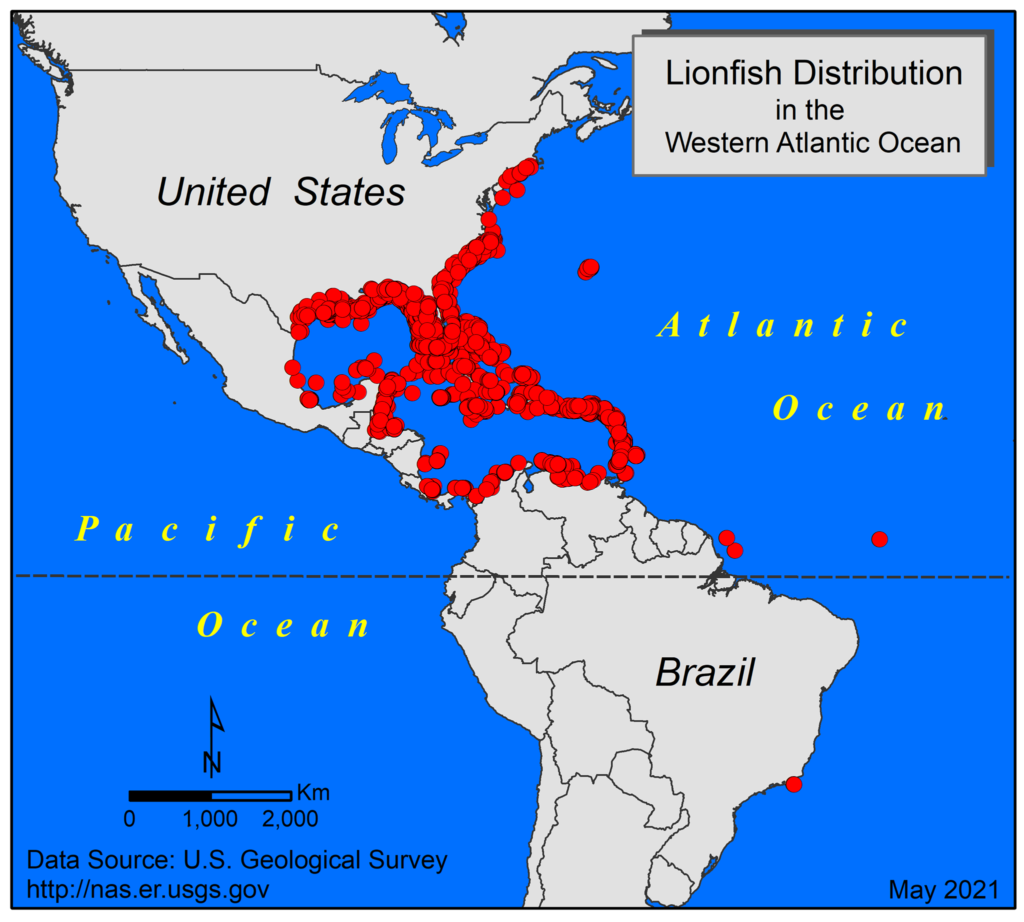
Just as humans began to move to places far and wide across the globe, Lionfish also started to disperse around the world in the mid-1980s. Scientists generally believe that humans played a role in this dispersion, bringing the beautiful looking Lionfish to North America to keep them in fish tanks and aquariums. When these fish owners could no longer care for or afford to feed the animals, which can grow up to 18 inches long and weigh up to 2.5 pounds, they may have released them into the ocean. One particular unsubstantiated rumor I’ve heard is that a group of the North American Lionfish population actually started from a few fish that escaped in Miami, Florida after historic Hurricane Andrew in 1992 cracked a tank they were housed in and released them into the wild. Other stories that explain the spread include adventurous Lionfish who hitched a ride on ships across the ocean from their native habitat.
Because these fish are not from this part of the world, they have no natural predators. This means that they are essentially at the top of the food chain – the kings of the underwater jungle. And when you’re the king, you can grow and reproduce out of control. Lionfish mature within as little as two years and can spawn multiple times in one season. Did you know each spawn can produce up to 2 million eggs a year? That’s a lot of babies!
As a result, the Lionfish population has swelled out of control, causing significant disruptions of the coral reef ecosystems. They are voracious predators whose stomachs can balloon up to 30 times their size! They can also go weeks without eating. These invasive fish out-compete grouper, snappers and other native fish for food and resources, leaving them to starve and their populations to dwindle. As the Lionfish overfeed on shrimp, lobsters, and crabs, they also negatively impact these populations as well. They even eat herbivorous fish that graze and protect coral from micro-algae overgrowth. Over time this can have devastating effects on the natural fish, coral and plant populations, reducing biodiversity and causing extinction. This is where I come in. As a lifetime scuba diver and environmentalist, I hate the idea of the native fish that I have observed with awe for decades going the way of the dodo bird.
Because Lionfish are so successful, it is unlikely that the population of these predators will be kept in check by natural means in the future. In addition to their high reproductive potential, voracious appetites and lack of natural predators in North America, Lionfish are incredibly hardy and can exist at a variety of depths and different type of habitat conditions, leaving few options other than human intervention. One way in which humans have begun to counteract the Lionfish population growth is by making a sport out of killing the invasive species. Lionfish hunters, travel these areas in the southern United States and the Caribbean to participate in the unique sport of spearing and capturing Lionfish.
International Lionfish Hunting – Combating Invasive Species
Now that you know about the issue – we get to the fun part – my passion for Lionfish hunting. Every time I giant stride off the back of a dive boat or do a beach dive entry, my heart starts to race with the excitement of finding a nice juicy Lionfish. In most areas it takes a lot of work to track down the fish. We scan large areas while kicking slowly to conserve air in our scuba tanks. We check under rock ledges, caves, and in and around any sunken boats or structures we find. In most areas once you find a Lionfish, they are easy to spear since they usually do not react to human presence. This is likely because they have no predators, so they never need to worry about getting eaten! When you finally do get close enough to a Lionfish that they notice you, they will defensively tilt their bodies with the top spines towards you in order to protect themselves rather than swim away. This makes them harder to spear. In my more recent dives, I’ve seen Lionfish start to take off when they hear the divers’ bubbles – they are very fast swimmers! It’s likely that these fish have been speared before and have smartened up. No matter the circumstance, it is always important to remember to get a proper angle on your shot so that you do not damage the fragile coral that might be nearby.
Each Professional Lionfish-hunter that I know has their own ways of hunting this invasive species. My friends in Cuba use spear guns while the Park Rangers in Bonaire use nets or a special Eliminate Lionfish spear, also known as the ELF, which is very short, spring loaded and hard to use. Bonaire has very strict weapons laws, however they allow the use of the ELF spear. This is how serious the Bonaire government is about protecting their marine parks around the island. My friend in Aruba, Norman Arends, introduced me to the Foldspear and now I exclusively use this device wherever I go (with some exceptions based on local laws of course). This spear is available in four, six or eight foot versions. They are manufactured in Florida by my friend Andy Lowe who is a former nuclear electrician and U.S. Navy diver who served aboard a fast attack submarine. I love getting and out of the water with the Foldspear! This is because it neatly folds up on my leg in a pouch. As a result, I have less items to carry, not to mention that it also makes it much safer diving around other scuba divers since I don’t have a spear tip sticking out.
One of my favorite Lionfish dives was in Aruba. We jumped off a 30-foot cliff in Aruba, into the water below. There was no other entry point to access the area we wanted to dive, so Boca Mahos which is near the Bushiribana Gold Ruins, on the Northern shores of Aruba was our only option. Most people do not dive in this area because the water currents and riptides are incredibly strong! Once in the water, divers have a long swim and rough exit point because of the regular five foot waves there. You need to be an experienced diver to do this dive. After we made the jump, we proceeded to submerge to 110 feet where we were greatly rewarded with a huge group of Lionfish. The trek was definitely worth it – we came up with over 23 Lionfish!
In another great dive in 2012, I dove with Pedro Rodriguez, an Independent Cuban Divemaster, who specializes in spearing Lionfish. Pedro would always use a spear gun to shoot the Lionfish. However since he did not have a containment device, he cut each fish underwater, first removing the spines with his dive knife on rock and then put the Lionfish in his buoyancy control device (BCD) jacket. When we got back to the Cuban shore, Pedro cleaned the insides of the fish out and then skinned it. Thanks to his hard work we all ate fresh Lionfish Sashimi.
What Is It Like to Get Stung By a Lionfish Venomous Spines? And What Should I Do if it Happens to Me?
Although Lionfish might sound scary, they are not dangerous if handled correctly. Only the spines on the Lionfish are venomous. Once removed, the Lionfish cannot harm a human. Additionally, Lionfish will not attack humans underwater but instead will choose to flee to safety when they feel threatened. If stung by a Lionfish, do not panic. While it is painful, getting stung is likely not fatal, although severe allergic reactions are possible. Likely side effects include blistering, intense local pain, swelling and in some more severe cases shock, necrosis and infection are also possible. Divers and swimmers should do everything in their power to avoid the venomous spines of the Lionfish. Stings can occur even after a fish is dead, so it is essential to handle even dead Lionfish safely. Also regardless of how big or small, the Lionfish and their venom are still painful. Don’t underestimate the little guys!
I was unfortunately stung by a Lionfish while in Panama in 2014. I was 60 feet underwater when the sting occurred, at a dive site three hours away from Panama City in Colon, Panama. After I was stung in my left thumb, I immediately aborted my dive and made my way up to the boat. I knew that there was no cure for the sting and the only thing that I could do was to submerge the injured thumb into hot water. The Divemaster helped me to get the pot of water and boiled it over a stove. For the first hour, I felt pain like I had never felt in my life before. At the time I was semi-seriously joking that if I had a knife, I would have considered cutting off my finger! Many people have told me the pain of a Lionfish sting can be compared to a snake bite.
The pain was intense! The only thing easing my pain was the hot water I’d submerged my finger in using a makeshift container made from a plastic bubble gum container. After I got off the boat the realization set in that I still had a three-hour ride back to my hotel. There was no way the boiling water was going to stay hot the entire trip. As expected, after the water started to cool down the pain was unbearable. With each bump of the van along the road, pain radiated up my left arm! Luckily the driver found a small cafe on the ride to microwave my plastic water container. After suffering for three hours, I got back to my room, boiled up some water and then spent the next day sticking my finger in the coffee cup. The burning feeling from the boiling water was a relief compared the pain I was feeling!
When I got back the hotel, I immediately called the Divers Alert Network, whose mission is providing emergency medical assistance and promoting dive safety. DAN has great divers accident insurance coverage and a hotline that helps injured divers. The doctor who answered the phone recommended that I clean the wound, make sure all spines were removed and then soak my thumb in hot water for approximately 30 minutes. Hot water helps to breakdown the venom and therefore decrease pain.
Once while driving the boat to a diving site, my friend in Jamaica, Captain-PADI Instructor Alton Williams, asked me what it felt like to being stung. Unfortunately for him, after our dive in November 2017 with me, he found out for himself what the feeling was like after stepping on a broken spine that was detached from a speared Lionfish and was lying on the boat floor. It was crazy to see how a little piece of spine that was laying on the boat deck caused such an injury and pain to Alton. As mentioned previously, it is essential to handle Lionfish safely and make sure the spines do not break off when placing into the container or dumping them out of your containment device!
As a recap, here’s some steps you can take if you do come in contact with Lionfish venom:
- If you are underwater, signal to your buddy to end the dive and return to the boat or shore immediately
- Clean the wound and remove debris and spines from site
- Immerse affected area in hot water to breakdown venom
- Alert DAN or other medical professional
An Unexpected Delicacy
Once I’ve caught the Lionfish though, I hate to let all that fresh meat go to waste! As a result, my friends and I have found many creative ways to cook and eat them. In my opinion, Lionfish is a bit firmer than Mahi Mahi and has wonderful tasting lean white meat that is delicious, with no oily or fishy taste at all. I’ve found through my travels that some people are afraid to eat Lionfish because they believe them to be poisonous. Surprisingly, Lionfish are not poisonous to eat although their spines do have venom in them! Once the venomous spines are removed, the Lionfish are completely safe to eat.
Every Lionfish I have ever speared and cleaned to eat or give away for others has always consisted of white meat only. Although I was raised in a fishing family, I never really enjoyed eating fish with the exception of maybe Mahi Mahi, Swordfish, and Tuna. However, I love eating Lionfish! They are excellent fried, sauteed, broiled, baked, blackened, or even eaten Ceviche style! I had one of my best Lionfish dinners ever during Thanksgiving this past year. After eating shrimp tempura at a Sushi restaurant the night before, I had a great idea about taking my freshly cleaned Lionfish to the Japanese chef and have it cooked tempura style. I had an excellent meal of Lionfish fingers with my wife, Andrea!
I’ve also tried Lionfish raw Sashimi style in Cuba with Pedro Gonzalez, a PADI Divemaster. He filleted the Lionfish underwater after he used his spear gun to shoot each Lionfish. Another time I ate Lionfish at the Hyatt in Aruba. The hotel Chef was surprised when I walked in with my catch of Lionfish! The fish was fried whole, cooked with lemon and lime to make ceviche. On this occasion, I had another great Lionfish and lobster dinner with my Aruban friends Norman and Charlotte! Interested in cooking your own Lionfish meal? One of my favorite ways to eat freshly speared Lionfish is to take the fillets and put them in a pan with butter, salt, pepper, lemon and a little water and cook them for about two minutes on each side.
As a result of the influx of Lionfish, many countries are just beginning to learn how good Lionfish are to eat. In Aruba, a Lionfish Trainer and PADI Instructor was the first to find a Lionfish in Aruba in 2009. He has since won many awards from the government and others for helping the Aruban environment and educating others about the damage the Lionfish is doing to the underwater ecosystem. He was one of the first people to introduce Lionfish to the Aruban people at a local monthly marketplace. He would spear fish all month long, clean them, freeze them and then cut them up into little nuggets and then bring them to the market with a small fryer and serve fried Lionfish nuggets. At the beginning of this venture, many people were scared to eat the Lionfish since they thought the fish were poisonous like blowfish. At first, he had a hard time selling any of the nuggets. After he started giving samples out though, people tasted how wonderful Lionfish were. Ever since, he has sold out every time he has his stand at the market.
Paving the Way For the Future
During my travels through the Caribbean searching for Lionfish, I have met many incredible scuba divers, fisherman, scientists, and government officials. I desire to keep learning more about Lionfish and try to bring my Lionfish hunting skills to areas of need whenever I can.
One particularly exciting area of interest has been the new ideas generated about how to collect and trap Lionfish. One idea I’ve recently been reading up on is using remote-controlled underwater robots that actually vacuum Lionfish up into a canister. This could be revolutionary, especially because it can access Lionfish at depths usually inaccessible to recreational divers. Others are working on enhanced Lionfish trap, like Stacy Frank from Lionfish University, Alex Fogg from Florida Fish and wildlife Conservation Commission and Dr. Steven Gittings Ph.D., the chief scientist from NOAA’s National Marine Sanctuary System.
In addition to spearing, I have also worked with marine biologists and researchers to catch, help measure, dissect and record the stomach contents of Lionfish. In 2010, my daughter Taylor and I dove with a Bonaire National Marine Park Ranger from the Stinapa National Parks Foundation to look for Lionfish. Once we caught the fish with nets, we placed them in clear plastic containment bags. The ranger was very proud of the 365 fish she netted up to that point in her career, which were all used in research. After we caught the Lionfish, we brought them back to Captain Don’s Habitat, where marine biologists and researchers from the Bonaire conservation office, Stinapa, would measure, photograph and check the stomach contents to find out what the fish were eating. It is crazy to think a Lionfish will eat anything it can fit in its mouth, even if it is close to its own size! This research is important because it helps us to better understand the kind of fish and creatures that Lionfish eat. As we learn more about them, we get closer to understanding how we can best cope with the invasive species. It is important to learn what effect they have on the marine environment and its native organisms.
Join the Movement
The Lionfish population is growing at such an exponential rate that it is imperative that every person do what they can to prevent additional invasive species from entering the North American waters and to impede the population growth as much as possible. To help with this effort, my friend Captain Andy Ross runs the World Lionfish Championships each May in Florida and Alabama. If someone wants to get involved in Lionfish hunting, this is a great event to attend! I also recommend that you purchase a Foldspear and spear tips from Andy Lowe who owns Lionfish Hunting, and a Zookeeper, which is a Lionfish containment device from Allie Elhage.
To eradicate the invasive Lionfish population, the humans need to spear, net, shoot and hunt them one at a time – this is going to take a lot of help! Remember, these animals have no known natural predators, so human intervention is the only hope to bring the ecosystem back into balance.
Check for local laws and regulations in each country you visit. They might have existing programs set up or restrictions on what types of equipment you can use. For example, the Bonaire government encourages scuba divers to carry sighting markers which are a recycled wine cork with brightly colored survey tape tied to it. Markers can be picked up at the Marine Park office and some of the dive shops. If a Lionfish is found, the diver can mark the area by tying the tape around a rock. Once alerted to this, Lionfish hunters and Park Rangers will go find and remove the sighted Lionfish. This is usually effective, as Lionfish seem to generally be territorial and will stick to one area until the food source runs out. The markers are located by Marine Park workers and volunteers.
If you are interested in learning how to become a certified Lionfish hunter or just helping with this environmental cause by diving, snorkeling, spearing, netting, or any other way of removing Lionfish from the Ocean, please email me Roger J. Muller, Jr. at roger@mullerinsurance.com or check out my list of where you can dive and become a certified Lionfish Spearer-Hunter. I created my website lionfishdivers.com to spread the word about the venomous Lionfish and their destruction of local ecosystems. My goal is to educate people with anything to do with Lionfish, from cooking and eating them, to removing them from the Atlantic and Caribbean by hunting and spearing them. I look forward to continuing to add to my photo, video, articles and recipe sections in order to share my passion with you!
About the Author
I’m from Hoboken, New Jersey and although it doesn’t seem like the expected place for a Lionfish hunter to reside, it has been my home base throughout all my adventures. I am an experienced International Lionfish Hunter and professional scuba instructor with both the Professional Association of Diving Instructors (PADI) and the National Association of Underwater Instructors (NAUI) that has tracked and hunted the fish throughout North America, many times in partnership with local organizations. I kill Lionfish to restore the natural balance in these areas and prevent the marine animal from causing any more destruction to the coral reef ecosystems I have dove in for over 20 years.
To give you a little background on myself, my day job (because we all need one of those…) is actually as an insurance agent. I know what you’re thinking here – insurance is a pretty boring career choice – and you’re right – which is why I had to look for a little more extracurricular fun when I wasn’t at work. Although I’m a business person by trade, I’ve always loved science and conservation and actually graduated with an Environmental Science Degree with honors from Ramapo College in Mahwah, NJ. After school, I went into my family business, Muller Insurance of Hoboken, NJ, in order to continue my father and grandfather’s legacy and serve my community as they had for over 112 years.
After my first scuba dive in 1998, I immediately fell in love with the underwater environment and the sport of scuba diving. After completing over 111 diving certifications from PADI and NAUI, I became interested in the Lionfish issue after seeing and hearing about the epidemic seven years ago in Bonaire. After that initial exposure, I took a handful of Lionfish training courses, including the SDI Hunter / Collector Diver, DAN & NAUI Hazardous Marine Life, PADI Lionfish Awareness and Elimination, Lionfish Hunting Specialty, and Invasive Lionfish Tracker Specialty courses. Hunting Lionfish has been so fun for me and scuba dive with a mission each time I get into the water. Today, I have over 1,500 Lionfish kills! Last year I became a field reporter for Lionfish University who is dedicated to preserving our oceans, reefs, native fish populations and raising awareness of the importance of maintaining our fragile ecosystems.
In 2016 Drew Richardson, President and Chief Executive Officer of PADI Worldwide, presented me with the President’s Club, Outstanding Achievement Award for my outstanding dedication, commitment and achievement in diving and lifelong diver education with 90 PADI Certifications.
Besides loving to spear and remove as many Lionfish from the ocean that I can, I am a big fisherman and a fish tagger for the American Littoral Society. During the 2017 fishing season, I had one of my best years fishing in New Jersey, catching a 90 pound Wahoo, 50 pound Bull Shark, Bluefin Tuna, Yellowfin Tuna, Mahi Mahi, and a few 35-pound Striped Bass in the Hudson River. I’ve also caught many Black Sea Bass, Fluke, and Porgies in this area as well. I am also a Lifetime member of the Hudson River Fishing Association (HRFA).
Citations
- Morell, V. (2010, April 29). Mystery of the Lionfish: Don’t Blame Hurricane Andrew. Retrieved March 16, 2018, from http://www.sciencemag.org/news/2010/04/mystery-lionfish-dont-blame-hurricane-andrew
- US Department of Commerce, & National Oceanic and Atmospheric Administration. (2016, July 28). What is a lionfish? Retrieved March 16, 2018, from https://oceanservice.noaa.gov/facts/lionfish-facts.html
- Gupta, A. (2009, May 07). Invasion of the Lionfish. Retrieved March 15, 2018, from https://www.smithsonianmag.com/science-nature/invasion-of-the-lionfish-131647135/
- Invasive lionfish likely safe to eat after all. (2014, August 14). Retrieved March 15, 2018, from https://phys.org/news/2014-08-invasive-lionfish-safe.html

